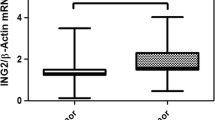Abstract
Mutations in p53 gene are the most frequent gene alterations in human cancer. In this study, we have used the monoclonal antibody (DO7) to evaluate the role of the p53 gene mutation in the progression of basal cell carcinomas towards invasion. We tested the positivity for p53 protein in tumor cells in six cases of basosquamous cell carcinoma (BSCC), in twelve cases of infiltrative basal cell carcinoma (IBCC) and twenty-four cases of non-infiltrative basal cell carcinoma (NIBCC) in order to evaluate its potential prognostic significance. We also tested the expression of p53 protein in normal epithelia adjacent to carcinomas in order to determine its role in tumor progression. p53 protein staining with some peripheral accentuation was identified in 42,9% of all groups. No correlation was found between the immunreactivity of p53 protein and recurrence, pattern of tumor, diameter of the tumors and sex. However, there were statistically significant differences in positivity of p53 protein in normal epithelia adjacent to carcinomas and age of patients (t value: 2,21; p: 0,034). Results of the study suggest that the increase in p53 mutation frequency of morphologically normal epidermis was related to age and was independent of the degree of differentiation of BCC.
Similar content being viewed by others
References
Barret TL, Smith KJ, Hodge JJ, et al: Immunohistochemical nuclear staining for p53, PCNA and Ki-67 in different histologic variants of basal cell carcinoma. J Am Acad Dermatol 37:430–437, 1997.
D’Errico M, Calcagnile AS, Corona R, et al:p53 Mutationsand chromosome instability in basal cell carcinoma s developed at an early or late age. Cancer Res 57:747–752, 1997.
De Rosa G, Staibano S, Barra E, et al: p53 Protein in aggressive and non-aggressive basal cell carcinoma. J Cutan Pathol 20:429–434, 1993.
Dixon AY, Lee SH, McGregor DH: Histologic evolution of basal cell carcinoma recurrence. Am J Dermatopathol 13:241, 1991.
Gunterson BA, Anbazhagan R, Warren W: Expression of p53 in premalignant and malignant squamous epithelium. Oncogene 6:1785–1789, 1986.
Helander SD, Peters MS, Pittelkow MR: Expression of p53 protein in benign and malignant epidermal conditions. J Am Acad Dermatol 29:741–748, 1993.
Jones MS, Helm KF, Maloney ME: The immunohistochemical characteristics of the basosquamous cell carcinoma. Dermatol Surg 23:181–184, 1997.
Kirkham N: Tumors and cysts of the epidermis. In: Lever’s histophology of the skin (Eds: Elder D, Elenistas R, Jaworsky C, Johnson B). 1997, pp 719–731. Philadelphia New York, Lippincott-Raven.
Liang SB, Ohtsuki Y, Furihata M, et al: Sun-exposure and ageing-dependent p53 protein accumulation results in growth advantage for tumour cells in carcinogenesis of nonmelanocytic skin cancer. Virchows Arch 434:193–199, 1999
Matsumura Y, Nishigor C, Yagi T, et al: Characterization of p53 gene mutations in basal-cell carcinomas: comparison between sun-exposed and less-exposed skin areas. Int J Cancer 65:778–780, 1996.
Onodera H, Nakamura S, Sugai T: Cell proliferation and p53 protein expressions in cutaneous epithelial neoplasms. Am J Dermatopathol 18:580–588, 1996.
Ro YS, Cooper PN, Lee JA, et al: p53 protein expression in benign and malignant skin tumours. Br J Dermatol 128:237–241, 1993.
Sexton M, Jones DB, Maloney ME: Histologic pattern analysis of basal cell carcinoma. J Am Acad Dermatol 23:1118 1126, 1990.
Shea CR, McNutt NS, Volkenandt M, et al: Overexpression of p53 protein in basal cell carcinomas in human skin. Am J Pothol 141:25, 1992.
Urano Y, Asano T, Xoshimoto K, et al: Frequent p53 accumulation in the chronically sun-exposed epidermis and clonal expansion of p53 mutant cells in the epidermis adjacent to basal cell carcinoma. J Invest Dermatol 104:928–932, 1995.
Author information
Authors and Affiliations
Corresponding author
Rights and permissions
About this article
Cite this article
Demirkan, N.C., Colakoglu, N. & Düzcan, E. Value of p53 protein in biological behavior of basal cell carcinoma and in normal epithelia adjacent to carcinomas. Pathol. Oncol. Res. 6, 272–274 (2000). https://doi.org/10.1007/BF03187330
Received:
Revised:
Accepted:
Issue Date:
DOI: https://doi.org/10.1007/BF03187330




